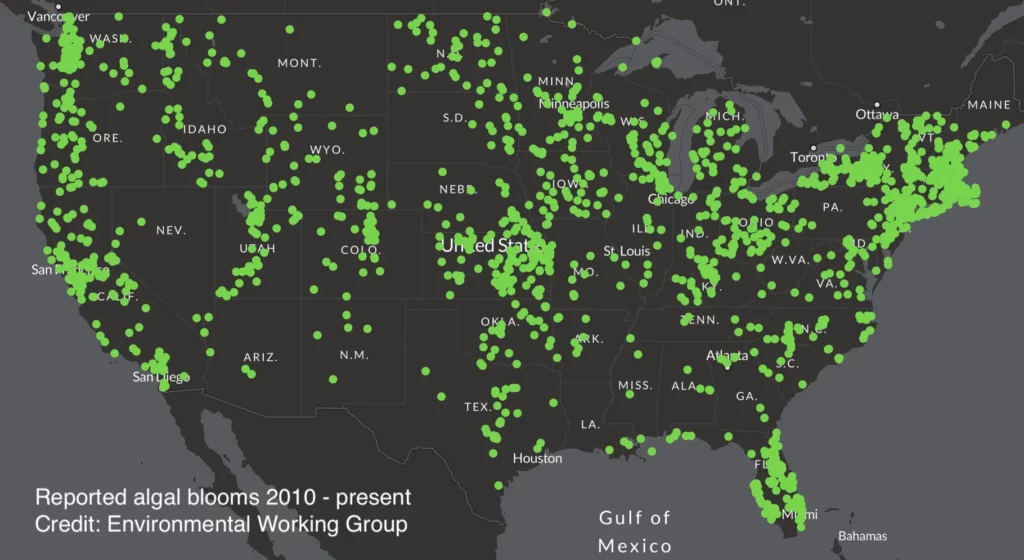
With summer in full swing, so is the season of toxic blue-green algae and the swimming and fishing closures that come with it. Local media coverage tends to do a great job of reporting on closures and health concerns so, in this issue backgrounder, we dig not only into the basics of hazardous algal blooms (HABS) but driving causes, the climate connection, and available solutions.
(Ps. We loved this San Francisco Chronicle story from earlier this month! Why toxic algae blooms are on the rise around California)
Background
- The terms toxic algae, blue-green algae, or harmful algal blooms (HABs) refer to cyanobacteria that are found in all water bodies, but are only dangerous when they grow out of control due to over-fertilization — due to chemical fertilizers and manure as well as under-treated sewage.
- Warmer, slow-moving water, something we’ll see more of as climate change reduces river flows and increases water temperatures, creates the conditions where toxic algae thrive. Scientists say climate change will drive the spread of toxic algae.
Impacts
- This is a water issue that touches people all across the country. Florida’s Red Tide, Lake Erie, and the Klamath River are just a few of the extreme examples that endanger wildlife and threaten public health. Trackers from the Environmental Working Group and NRDC show that all 50 states have reported blooms, and reports have tripled since 2010.
- Toxic algae doesn’t just threaten public health, but also drives up the cost of drinking water. New research from the Alliance for Great Lakes found that an average family of five in Toledo pays $100 more for their water per year to cover the monitoring and treatment needed to deal with harmful algal blooms. The group is calling for standards to ensure upstream farmers do more to reduce nutrient pollution and ensure ratepayers don’t bear the cost burden.
- The California HAB incident report map shows advisories for several water bodies, including Clear Lake, Discovery Bay, Lake Chabot, and Pinto Lake, where either visual observation or water testing have indicated unsafe levels of cyanobacteria.
- Warmer weather and less flowing water contribute to toxic algae in the Colorado River Basin, as seen in reporting from Steamboat Lake and the Yampa River last summer. Add toxic algae to the list of threats and concerns around water levels and quality in Lake Mead.
Solutions
- Ensure water flows through rivers. This means reducing the amount of water we take out of rivers in dry years, and removing dams. On the middle Klamath River, removing dams and restoring natural flows will be a game changer for water health, a victory for Tribal self-determination and the Tribes along the Klamath fighting to restore salmon and their way of life.
- Strengthen the Clean Water Act. This year, we’re celebrating the 50th anniversary of the Clean Water Act, landmark legislation that has been incredibly successful in regulating pollution from industry and city sewage. More needs to be done to set clean water standards for urban and agricultural runoff, yet, as we speak, the Supreme Court could roll back the scope of Clean Water Act protections.
- Reduce pollution flowing from farms. Regenerative agriculture and other practices like using cover crops, precision fertilizer application, fencing streams, and planted streamside buffers keep more nutrients on the land.
- Invest in multi-benefit solutions. In the West, many of these strategies bring multiple benefits to the landscape by storing carbon, bolstering soil health and conserving water. The five-year Farm Bill is being renegotiated now, and clean water groups are urging an increase in conservation funding, and an end to subsidies for super polluters like concentrated animal feeding operations.
To keep up with our team and get the latest communications resources or workshops, follow us on Twitter at @Water_Hub or sign up for our monthly-ish newsletter, the Water Cooler.